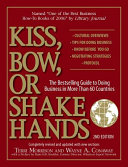

Cultural awareness is crucial in today's globalized world. The book emphasizes the importance of understanding different cultures to navigate international business successfully. It highlights that what may be considered polite or respectful in one culture can be perceived as rude or inappropriate in another. For instance, in some Asian cultures, bowing is a common greeting, while in Western cultures, a firm handshake is the norm. The book provides insights into various cultural customs and etiquette, helping readers to avoid misunderstandings and build stronger relationships with international partners. This understanding can lead to better negotiations, smoother interactions, and ultimately, business success. The book encourages readers to research and adapt to the cultural contexts they are operating in, reinforcing the idea that cultural sensitivity can enhance communication and collaboration.
Continue readingBusiness etiquette plays a significant role in establishing professional relationships. The book outlines specific etiquette practices that vary from culture to culture, such as dress codes, gift-giving customs, and meeting protocols. For example, in Japan, it is customary to exchange business cards with both hands, while in the United States, a casual introduction may suffice. Understanding these nuances can prevent faux pas that could jeopardize business deals. The authors stress that demonstrating respect for local customs can create a positive impression and foster trust. They provide practical tips on how to adapt one's behavior to suit different cultural contexts, making it easier for professionals to engage effectively with international colleagues and clients.
Continue readingDifferent cultures have varying communication styles, which can lead to misunderstandings if not recognized. The book categorizes communication approaches into high-context and low-context styles. High-context cultures rely heavily on non-verbal cues and the surrounding context, while low-context cultures favor direct and explicit communication. For instance, in cultures like Japan or China, indirect communication is often preferred, whereas in cultures like the United States, directness is valued. The book offers strategies for adapting communication styles to fit the audience, such as being more attuned to non-verbal signals in high-context settings. This understanding can significantly improve interpersonal interactions, reduce conflict, and enhance collaboration across borders.
Continue readingNegotiation tactics can vary widely between cultures, and the book provides insights into these differences. It emphasizes that understanding the cultural background of negotiation partners can lead to more successful outcomes. For instance, some cultures may prioritize building relationships before discussing business, while others may prefer to jump straight into the details. The authors suggest adapting negotiation strategies based on cultural preferences, such as being patient and building rapport in relationship-oriented cultures or being concise and straightforward in task-oriented cultures. This awareness can lead to more effective negotiations, as it allows for a tailored approach that respects the values and expectations of all parties involved.
Continue readingThe book discusses the importance of developing global business strategies that take cultural differences into account. It emphasizes that a one-size-fits-all approach is often ineffective in international markets. Businesses must adapt their strategies to align with local customs, consumer behavior, and market dynamics. The authors provide case studies and examples of companies that have successfully navigated cultural differences to achieve global success. They highlight the need for cultural intelligence in market research, product development, and marketing strategies. By understanding the cultural nuances, businesses can create more relevant offerings and connect better with their target audiences.
Continue readingBuilding strong relationships is a cornerstone of successful international business. The book highlights the significance of trust and rapport in various cultures, emphasizing that relationship-building often takes precedence over transactional interactions. It discusses the importance of networking and establishing personal connections, particularly in cultures where business is conducted on a personal level. The authors provide tips on how to cultivate relationships, such as engaging in social activities, showing genuine interest in partners' backgrounds, and being patient in the relationship-building process. This focus on relationship-building can lead to long-term partnerships and collaborative opportunities.
Continue readingAdaptability and flexibility are essential traits for professionals working in a global environment. The book stresses the need for individuals to be open-minded and willing to adjust their approaches based on cultural contexts. It encourages readers to embrace diversity and view it as an opportunity for growth rather than a challenge. The authors provide examples of individuals and organizations that have thrived by being adaptable and culturally aware. They emphasize that flexibility in thinking and behavior can lead to innovative solutions and enhanced collaboration. This adaptability is crucial for navigating the complexities of international business and fostering a culture of inclusivity.
Continue reading